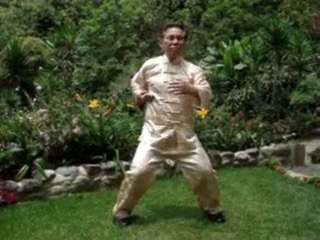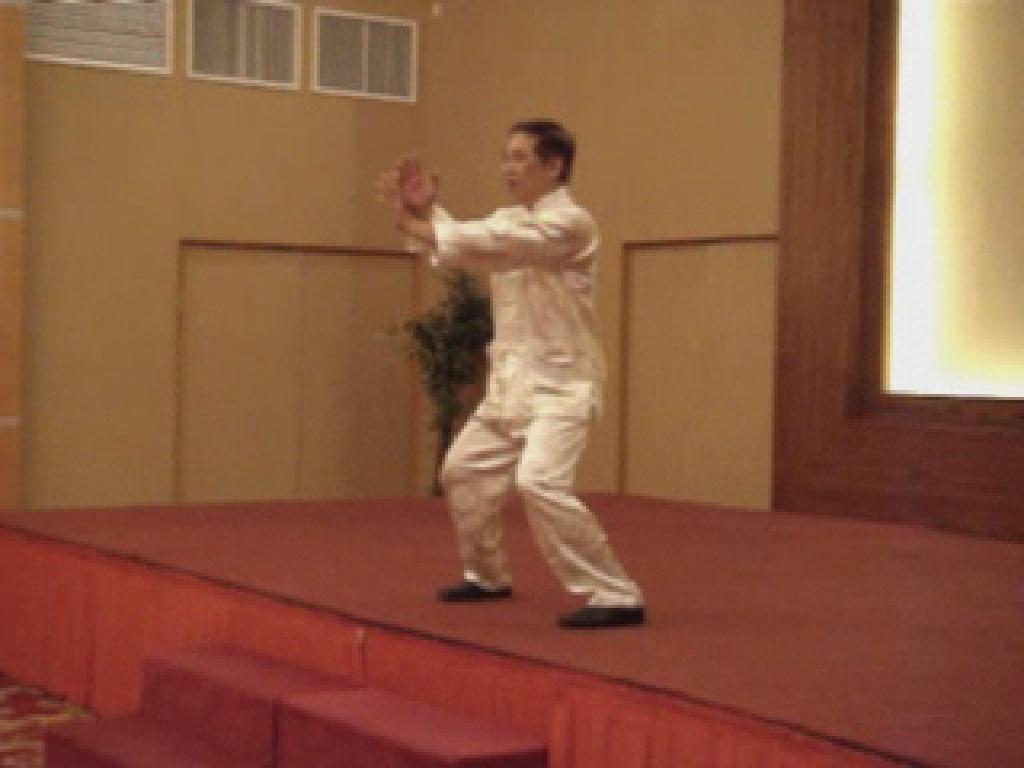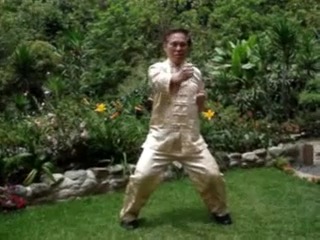CHAPTER 8 -- FORCE TRAINING AND WOODEN DUMMY

One can train a lot of internal force by practicing the fundmental Wing Choon Set, Siu Lin Tou
Force training is an intergral part of kungfu. Without force, one cannot inflict sufficient injury on an opponent, or exercise adequate control over an opponent to subdue him. Unfortunately many students do not realize this very important aspect, and consequently they just practice kungfu patterns without developing force. Force, in kungfu terminology, is not merely mechanical strenght. For convenient, kungfu force can be arbiturary classified into "hard" and "soft". Some examples of hard force are Iron Palm, Stone-Lock Force, and Iron Sweep, whereas some examples of soft force are Cosmos Palm, Art of Lightness, and Sinew Metamorphosis. Generally, hard force is acquired through conditioning with the aid of hard or heavy tools, such as sand bags and wooden poles; and soft force through the training of "chi", or intrinsic energy, and meditative exercises.
The force used in Wing Choon Kungfu is generally soft. Thus, one seldom sees Wing Choon exponents thrusting their hands into beans nor striking their arms against poles. Wing Choon force training is incorporated into set practice itself, particularly in the Siu Lin Tou set. If one practices this set consistently and correctly for some time, say, a year, with synchronous breathing and appropriate muscle-control, he will acquire soft force. Some soft force can also be acquired through Sticking Hands training.
The most famed Wing Choon soft force is "inch-force". It is so called because this kind of force can injure an opponent when executed within inches from the opponent's body. Inch-force is particularly useful in Wing Choon Kungfu, and combines excellently with Sticking Hands, as the proponent can inflict much injury at very close range.

It is reputed that Ng Mui, the teacher of Yim Wing Choon, developed tremendous internal force by training "Double Worshipping of the Buddha"
One method to develop inch-force is by practicing the pattern "Offering Wine" (Pattern 6 of the Wing Choon Set explained in Chapter 3). The training procedure is listed below.
- Stand at the goat-riding stance.
- Relax the body and clear the mind of all thoughts.
- Breathe in slowly and deeply through the nose.
- Breathe out slowly through the half-closed mouth, and let (but do not use force) "chi" sink into the abdomen. At the end of breathing out, swallow a mouthful of saliva.
- Place the cup-fist in front of the chest. Breathe in slowly and deeply. Concentrate force at the fist.
- Slowly move out the cup-fist until the arm is fairly extended, and breathe out simultaneously. Concentrate force at the fist as it is moved out.
- Slowly bring the cup-fist back to its original position in front of the chest. Breathe in simultaneously. Concentrate force at the fist.
- Repeat processes (6) and (7) once or twice, depending on the amount of force that has been generated at the fist. Then slowly move out the cup-fist again.
- When nearing the full extent of the arm, suddenly thrust out the fist quickly and forcefully. Simultaneously breathe out explosively.
- Swallow some saliva and the remaining "chi" into the abdomen. Then bring the extented cup-fist back to the original position in front of the chest. Breathe in simultaneously.
- Processes (5) to (10) are to be repeated a few times.
- Then the whole procedure is repeated using the other hand. At the end of the training, carry both fists at breast level. Bring the feet together, unclench the fists and lower the palms, facing downwards, along both sides of the body (as in the last pattern, Pattern 48, of the Wing Choon Set). Breathe out slowly as the palms are lowered, and then drop the wrists. Swallow the remaining "chi" and saliva at the end of the action.

The Cup-Fist
It is necessary to practice consistently and regularly, preferably in the morning and at night every day. The trainee must not be hasty, nor over-train himself. As the force involved here is internal, he must allow his force to develop gradually. After some time of dedicated training, he will find some inner force vibrating at his fist.
After about three months of daily training, one should have developed sufficient force to proceed to the second stage of training.
The training processes at the second stage are similar to those of the first, except that at the first stage the trainee concentrates his force at his cup-fist as he slowly moves it out, but at the second stage he relaxes his fist initially, concentrating his force only when nearing the full extent of his arm as he suddenly thrusts out his cup-fist. This procedure is to be practiced for another three months, so that eventually the trainee can strike an opponent forcefully within a striking range of only a few inches.
At the third stage of training, the trainee strikes out his cup-fist speedily, but uses force only at the end of the punch or at contact with an opponent. He should practice this punching technique from different angles using different patterns and stances. Three months of daily practice is required for this stage, making a total of about nine months for the whole training programme. This does not suggest that one can master soft force in nine months. As in all other types of kungfu training, there is no end ot one's practice and development; the more one trains the better he becomes. But nine months of correct training should enable a student to develop sufficient inch-force so that he can inflict decisive injury on an ordinary opponent at close range.
Although kungfu gadgets (like sandbags, stone-locks and rattan poles) are rarely used in Wing Choon Kungfu, there is one gadget that has become characterisrtic of Wing Choon, and this especial Wing Choon gadget is the wooden dummy. The wooden dummy, nevertheless, is also characteristic of Choy-Li-Fatt Kungfu.

Left Mirror-Hand and Right Pinning-Hand
The wooden dummy is normally made from a block of hard wood, shaped like a human, about five feet high, with wooden projections representing limbs. It acts like an opponent for the student to practice various combative techniques. The wooden dummy was not originally introduced by Yim Wing Choon, but probably by Leong Yi Tai who had learnt wooden dummy techniques from the Venerable Chee Seen, the abbot and grandmaster of the Shaolin Monastery in Fujian. In the Shaolin Monastery, a Shaolin disciple in his graduation test had to match his kungfu skills against ingeniously constructed wooden robots. When Chee Seen disguised himself as an odd job worker in a showboat and taught kungfu to Leong Yi Tai he devised a stationary wooden dummy for Leong Yi Tai to practice with, because mobile wooden robots would not be practical in the limited showboat environment. Chee Seen also taught Leong Yi Tai the Six-and-Half-Point Staff (which will be explained in the next chapter).
Many people erraneously believe that the main aim of practicing the Wing Choon dummy exercises is to harden the arms. Hardened or powerful arms are not essential in Wing Choon Kungfu because Wing Choon techniques emphasizes neutralizing opponents' force, and not meeting force with force. Secondly, if one wishes to strengthen his arms in Wing Choon systems, there are other more suitable methods. Conditioning the arms against wooden limbs of the dummy is not conclusive to Wing Choon training, because this will adversely effect the sensitiveness of the arms in Sticking Hands.
The main aim of the Wing Choon wooden dummy exercises is to enable the student to develop precision of his execution of combative techniques using the dummy as an imagined opponent for target practice. For example, if a student intends to strike the dummy's eyes, he must be able to hit the intended target every times without fail.

Left Circling-Hand and Right Cup-Fist
I stand at a goat-riding stance in front of a wooden dummy. Then I perform a simultaneous left mirror-hand and a right pinning hand, followed by a simultaneous right mirror-hand and left pinning hand against the wooden limbs of the dummy. Notice that both these actions are in-gate defences.
Next, I move a small step to my left side and execute a scissors-hands technique, an example of an out-gate defence. Immediately I move my right foot foward to the four-six stance and strike the dummy with a right cup-fist, while guarding the dummy's right limb with my left hand.
I retreat my left leg but move my right leg slightly forward forming the right bow-arrow stance, and simultaneously circle my left hand in a clockwise movement above and around the left wooden limb of the dummy, and thrust my right fingers at the dummy's throat.
Then I move my left leg forward into a four-six stance, and simultaneously block the dummy's left limb with my right mirror-hand and strike the dummy's chin with my left upright palm.
I move my right leg to my right side to form a right four-six stance, and execute a scissors-hand technique on the dummy's left limb.

Right Circling-Hand and Right Thrust-Kick
Stepping forward with my left foot to form the left four-six stance, and guarding the dummy's left limb with my right palm, I strike the dummy with my left cup-fist.
I maintain the left four-six stance, circle my right hand in an anti-clockwise movement above and around the dummy's left limb, and strike the dummy's throat with my left finger-thrust.
Following this, I move my right leg forward into the right four-six stance, and simultaneously execute a left mirror-hand on the dummy's left limb, and right upright palm strike at the dummy's face.
Then I move a big step with my left leg to my left side to form a left sideway bow-arrow stance, and simultaneously jab my right shooting-palm at the dummy's right arm-pit.
I execute a right thrust-kick, while blocking the dummy right wooden limb with my right hand.

Right Bow-Arrow and Left Shooting-Hand
Taking a big step towards my right side to form the right sideway bow-arrow stance, I execute a left shooting-palm to the left dummy's arm-pit.
Next, I send a left thrust-kick, with my left hand blocking the dummy's left limb.
Returning to a goat-riding stance, I execute in quick succession mh right, left, then right finger-thrust at the dummy's throat.
With an agile jump I bring my feet together and carry my clenched fists at breast level on both sides of my body, breathing in as I jump. Then I unclench my fists and lower my hands, breathing out in the process.
The wooden dummy is a heavy, massive tool. As it is not always feasible to carry about a wooden dummy easily, an appropriate figure drawn on a wall can often be used as a convenient substitute for the dummy.
Grandmaster Wong Kiew Kit,
18th July 2019.

Right Finger-Thrust in Goat-Riding Stance
LINKS
Introduction to Wing Choon Kungfu
Courses and Classes








